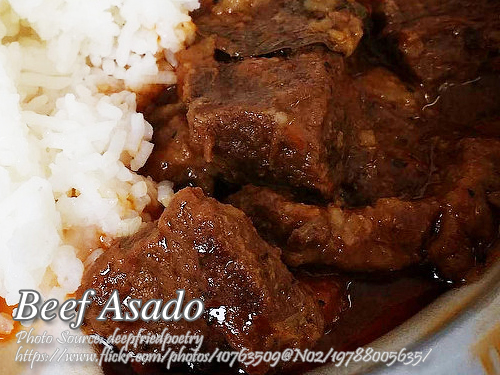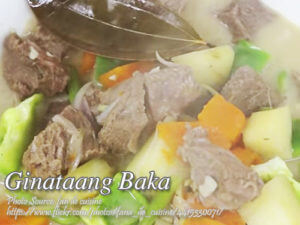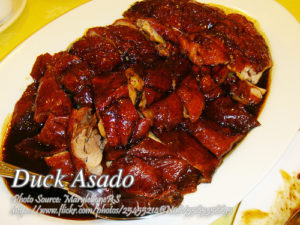Beef asado is a popular Filipino beef dish that are usually sold in carinderia or food courts serving Filipino dishes. It is also a simple dish to cook similar to beef stew or adobo where you only have to put everything in the pot and simmer it until tender. You can also add an extra step by combining the meat, spices and condiments, and let it simmer for a few minutes then add the water and let it boil and simmer until tender. This step will add more flavor to the meat then the usual way of cooking asado.
Discovering the Delights of Filipino Asado
Filipino cuisine is a tapestry of rich flavors and historical influences, with dishes like beef asado standing out as a beloved comfort food. This hearty dish, often found in carinderias (small eateries) and food courts across the Philippines, is akin to a beef stew or adobo, showcasing the nation’s love for slow-cooked, savory meals. While it may appear simple, its depth of flavor makes it a standout. Here’s a closer look at how to make this delicious dish and some intriguing tidbits about its history and variations.
The Simplicity and Depth of Filipino Cooking
One of the beauties of this asado dish lies in its straightforward preparation. Similar to other Filipino staples, it involves combining meat with spices and condiments, then simmering until tender. This method not only makes the dish accessible to cooks of all levels but also ensures that the flavors meld beautifully over time.
Ingredients that Make the Dish
The key ingredients for this dish include beef, vinegar, pepper, garlic, salt, bay leaves, and soy sauce. These components form the foundation, infusing the meat with a savory and slightly tangy flavor. The addition of water allows the beef to cook until tender, while fried potatoes and bell peppers provide texture and color. Achuete (annatto) juice, which gives the dish its distinctive reddish hue, adds an earthy undertone that rounds out the flavor profile.
A Step-by-Step Guide to Cooking
To prepare this hearty dish, start by placing the beef in a saucepan and adding vinegar, pepper, half of the garlic, salt, bay leaves, and soy sauce. Let this mixture boil for about five minutes to begin infusing the meat with these robust flavors. Next, add two cups of water and let it boil until the meat reaches the desired tenderness.
In the meantime, fry the potatoes until they are golden brown and set them aside. In a separate pan, sauté the remaining garlic, onions, and tomatoes. Once these are fragrant and slightly caramelized, add the meat mixture, potatoes, and bell peppers. Finally, pour in the achuete juice and let the entire mixture cook until all the ingredients are well combined and the flavors are thoroughly developed.
The Role of Achuete Juice
Achuete, or annatto, seeds are a common ingredient in many Filipino dishes, valued for their vibrant color and subtle flavor. To make achuete juice, soak one tablespoon of the seeds in two tablespoons of hot water for at least 30 minutes. After soaking, remove the seeds, leaving behind a richly colored liquid. This juice not only enhances the visual appeal of the dish but also adds a unique flavor that is integral to its authenticity.
A Historical Perspective
The origins of the dish can be traced back to the culinary traditions brought by Spanish colonizers. The term “asado” itself means roasted or grilled in Spanish, though the Filipino version is more of a braised dish. Over time, local ingredients and tastes influenced its evolution, resulting in the unique Filipino rendition we enjoy today. This dish, like many others in Filipino cuisine, reflects a blend of indigenous and foreign influences, creating a rich tapestry of flavors and cooking techniques.
Variations Across the Archipelago
While the basic recipe remains consistent, variations exist across the Philippines, often influenced by regional ingredients and tastes. In some areas, sweeteners like pineapple juice or sugar are added, creating a sweet-savory balance that appeals to different palates. Other versions might include additional vegetables or spices, showcasing the adaptability and creativity inherent in Filipino cooking.
The Cultural Significance
In the Philippines, meals are often communal affairs, bringing families and friends together. Dishes like beef asado play a significant role in these gatherings, providing a hearty and flavorful centerpiece that everyone can enjoy. Its presence in carinderias and home kitchens alike speaks to its widespread popularity and the comfort it brings to many Filipinos.
Serving and Enjoying the Dish
Traditionally served hot and often accompanied by steamed rice, thisis a versatile dish that can be enjoyed at any time of the day. Its rich sauce is perfect for spooning over rice, ensuring that every grain is infused with its delicious flavor. Whether enjoyed in a bustling carinderia or a quiet home kitchen, this dish embodies the warmth and hospitality of Filipino cuisine.
Final Thoughts
Beef asado is more than just a meal; it is a culinary experience that offers a taste of the Philippines’ rich cultural heritage. By combining simple ingredients with time-honored cooking techniques, this dish delivers a complex and satisfying flavor that has earned its place in the hearts of many. So the next time you’re in the mood for a comforting and flavorful meal, consider preparing this asado and savor the delicious history it brings to your table.
How to Cook Beef Asado
Ingredients
- 1 kilo beef cut into desired pieces
- 2 potatoes pared and divided into 6
- 1 big onion peeled and cut into cubes
- 1/2 head garlic
- 1 tsp. black pepper
- 1 1/2 cups native vinegar
- 2 1/2 Tbsp. cooking oil
- 1 pc. bay leaf
- 1 tsp. salt
- 2 Tbsp. soy sauce
- 2 small red/green pepper cut into slices
- 2 Tbsp. achuete juice
- 2 pieces tomatoes cut into small pieces
Instructions
How to cook beef asado:
- Place the meat in a saucepan and add vinegar, pepper, 1/2 of garlic, salt, bay leaf and soy sauce.
- Allow it to boil for 5 minutes.
- Add 2 cups water and let boil until meat is tender. Fry the potatoes until golden brown, then set aside.
- Saute garlic, onions and tomatoes; then, add in meat mixture, potatoes and red/green pepper.
- Add the achuete juice to the mixture and cook until done. Serve hot. Good for 6 persons.
To make achuete juice:
- For every 1 Tbsp. atchuete seeds, pour 2 Tbsp. hot water and let stand for at least 30 minutes.
- Remove the seeds and the liquid is your achuete juice.
Notes
Cooking Tips:
Marinate for Maximum Flavor
Before cooking, marinate the beef in vinegar, soy sauce, garlic, and bay leaves for at least an hour. This step allows the flavors to penetrate the meat deeply, enhancing its taste. The acidity of the vinegar also helps to tenderize the beef, resulting in a more succulent dish.Sauté for Depth
Sauté the garlic, onions, and tomatoes until they are caramelized and fragrant before adding them to the meat mixture. This process develops a richer, more complex flavor base for the dish. It also ensures that the aromatics fully release their flavors, infusing the beef with a deeper taste.Achuete Juice for Color and Flavor
Prepare achuete juice by soaking annatto seeds in hot water and straining out the seeds after 30 minutes. This vibrant liquid not only gives the beef asado its characteristic reddish color but also adds a subtle earthy flavor. Incorporating achuete juice enhances the visual appeal and authenticity of the dish.






hi Manny,
I am making your recipe here, but please explain ‘2 tbsps. achuete juice’ in your Asado dish.. i googled it, but don’t know what you mean. Can you please tell me.
I love the smell of it cooking! and look forward to trying your other recipes!
Thank you!
Michelle
Hi Michelle, sorry for not including the procedure of making the achuete (annato) juice. I’ve already edited the recipe that includes that procedure. You can also use achuete or annato powder which is more convenient if you can find one. Just use about half a teaspoon of the powder. Thanks for your feedback!